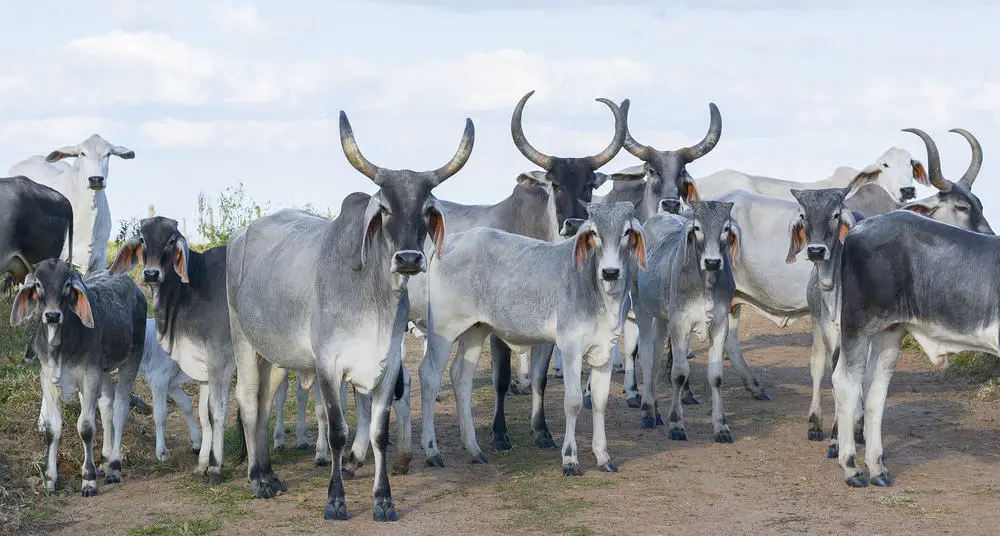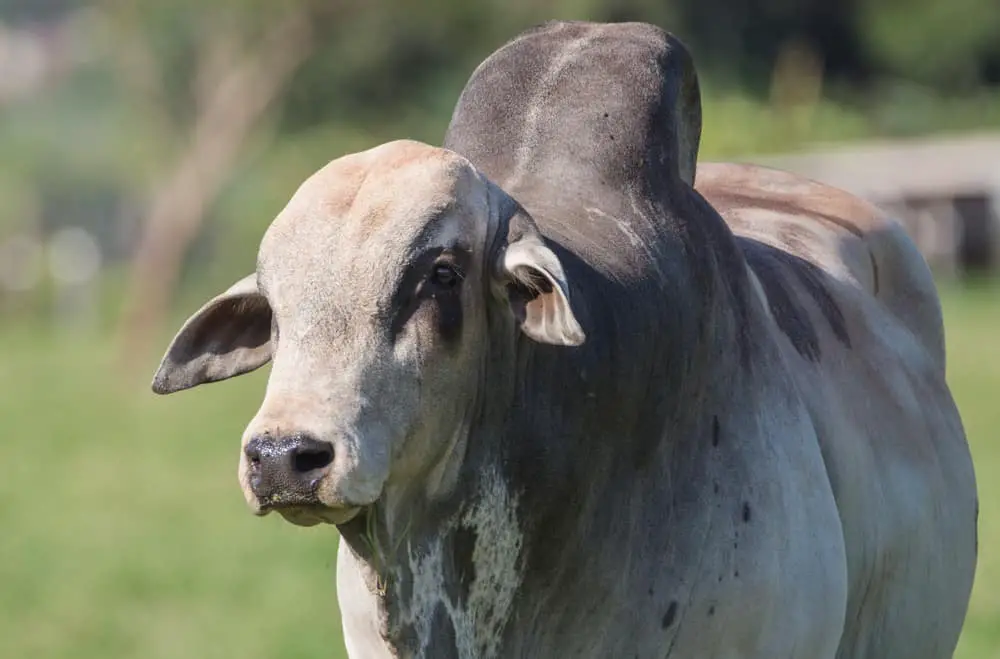Zebu is a species of cattle native to Africa and the Middle East. It is one of the most ancient domesticated animals in history, with evidence of its use by humans dating back thousands of years. The zebu has been used for many purposes, from providing dairy products and meat, to powering farming tools such as ploughs and carts. This article will explore these uses as well as delving into zebu anatomy and biology.
The zebu’s distinctive features make it easily recognizable among other breeds of cattle. Its horns are curved upwards slightly at the tips, often referred to as ‘lyre-shaped’, while its hump on the shoulders is much larger than that found on other types of cattle. Zebus also have drooping ears that give them an almost comical appearance when compared with other breeds.
In addition to their physical attributes, zebus possess numerous genetic advantages over non-zebu varieties which makes them particularly suited to life in tropical climates or areas prone to drought conditions.
They are able to survive harsh temperatures more effectively due to their natural adaptation to hot environments; they also require less feed than traditional cows as they can graze on coarse grasses and shrubs rather than relying solely on grain-based diets. Furthermore, their low birth weight allows for easier calving without compromising calf health or growth rate.

Overview Of The Zebu Breed
The Zebu, also known as the humped cattle or Indicus cattle, is a breed of domestic bovine originating from South Asia. Originating in India and Southeast Asia, zebus are now found around the world due to their hardiness and adaptability. Characterized by prominent humps on the shoulders and large dewlaps, these animals have adapted over centuries for use in harsh climates.
Zebus are used for many purposes including dairy production, beef production, and even riding animals. Their ability to produce milk with high fat content makes them popular amongst dairy farmers looking for an effective source of nutritious milk.
Additionally, their thick skin makes them well suited to hot climates that would otherwise be inhospitable to other breeds of cattle. Moreover, they can tolerate long periods without food or water better than most other breeds making them ideal for dry regions where feed availability may be limited.
Different types of zebus exist based on region-specific characteristics such as size, shape of hump, coloration and horn length/shape. These various subtypes allow producers to choose the type that best suits their needs while allowing local populations to maintain distinct lines of the animal that are uniquely adapted to the conditions in which they live.
In summary, the zebu has been domesticated for thousands of years due its hardy nature and suitability for multiple uses – both practical and recreational – across different climatic zones around the world. As a result it has become one of the most widespread species of livestock globally today.
History And Origins
The zebu is a species of cattle that has been around for centuries, with its history and origin being debated by researchers. Its exact origins remain unknown but it is believed to have originated in Asia, India or Africa.
In terms of zebu history, archaeological discoveries suggest they were first domesticated in the Indus Valley region, which was located in present-day Pakistan. From there, it spread to other parts of South Asia where it became popular among farmers due to its ability to thrive in tropical climates and resist disease better than other kinds of cattle. It eventually spread throughout Southeast Asia and then into Africa.
Today, the majority of all existing zebus are found in sub-Saharan Africa, where their numbers continue to grow rapidly as demand increases for their meat, milk and hides. They are also used as draught animals in many rural communities across the continent and can now be found on farms in Europe, North America and Australia too.
Overall, the zebu’s long history reflects its importance as an agricultural animal that has proved resilient over time despite changes in climate and environment.
Physical Characteristics
The zebu is an ancient breed of cattle that has been around for centuries, and its physical characteristics have changed very little over time. The first notable trait is the horns on its head; these are usually curved upwards or forwards in shape. The body type also tends to be compact with a large hump behind its neck and shoulders. Zebus come in many different coat colors; this includes shades of white, brown, gray, black and red.
Another feature is their hooves which tend to be more rounded than those of other breeds of cattle. This provides them with better traction when walking on slippery surfaces such as mud or snow-covered terrain. Additionally, the tail length varies between individuals but generally ranges from short to medium lengths.
Overall, zebus possess a unique set of physical characteristics that make them easily recognizable among other breeds of cattle. They have a strong build and sturdy legs which allow them to thrive in various climates and environments where other species may struggle to survive. Their horns provide protection against predators while their coats offer camouflage from potential threats. Furthermore, their hooves provide extra stability when traversing challenging landscapes and varying terrains. All combined makes the zebu an incredibly resilient animal capable of living in numerous habitats across the globe.
Temperament & Behavior
The temperament and behavior of Zebus are unique to the breed. They have a natural curiosity that makes them friendly, sociable animals when properly trained and socialized. However, they can also be very stubborn if not provided with proper training and guidance.
Here is what you should know about zebu temperament and behavioral traits:
- Zebus are naturally curious creatures who love human interaction. With patience and positive reinforcement-based training, they will become well-mannered family companions.
- Socialization needs to start early in life to ensure your zebu learns how to interact appropriately with people, other animals, and its surroundings. Training tips include clicker training as well as providing treats for good behaviors.
- Exercise requirements vary depending on the individual animal’s age, health status and environment but generally consist of daily walks or grazing in an open pasture area where the animal can move around freely.
Zebus are intelligent animals that thrive with structure and consistency from their owners. With regular exercise and plenty of mental stimulation, these animals make excellent companion pets for those willing to invest time into understanding their needs and building trust between themselves and their pet.
Care & Feeding Requirements
Zebus are a unique breed of cattle and require special care to stay healthy. Proper feeding is essential for the longevity of any zebu, as they have particular dietary needs that must be met in order to sustain good health. Zebus need adequate nutrition and pasture maintenance on a daily basis.
Daily diets should consist mostly of grasses or hay with moderate amounts of supplemental feed such as oats, barley, corn, or soybean meal. Additionally, minerals such as salt blocks or loose mineral mixes may also be added to their diet if necessary. It is important not to overfeed zebus, as this can lead to obesity which can cause additional health issues down the line.
For optimal health and growth, zebu owners should keep pastures mowed regularly and free from weeds and debris that could cause infection or irritation. Keeping plenty of fresh water available at all times is also key for hydration purposes. A combination of these factors will ensure that your zebu’s nutritional needs are being met properly throughout its lifetime.
It is important for zebu owners to adhere closely to recommended feeding guidelines in order to maintain a balanced diet for their animals. Doing so will help promote a long and healthy life for your beloved bovine friend!
Breeding & Showing
Zebu breeding is an exciting and rewarding endeavor, with many benefits. With the proper techniques and guidelines in place, zebu breeders can maximize the potential of their livestock. Breeding techniques should be tailored to meet the individual needs of each animal and include considerations such as pedigree and body type.
Zebus that have been bred for show will need special care when it comes to preparation and handling prior to entering a show ring.
In order to ensure successful results from both breeding and showing endeavors, certain fundamental points must be taken into consideration. A thorough understanding of genetics is necessary before beginning any sort of program or practice involving zebus.
Genetics play an integral role in determining the success of particular pairings, so it’s important to understand what affects an animal’s traits before making any decisions on breeds or pairs.
Additionally, familiarity with best practices for providing quality nutrition and healthcare is essential for those involved in raising animals for shows or stud services.
This knowledge helps keep animals healthy while allowing them to reach their full genetic potentials, which leads to higher-quality offspring with improved chances of success at competitions or sale events. Properly caring for zebus plays an essential part in producing strong specimens fit for use in either area: breeding or showing.

Health Concerns
Zebus are a hardy breed of cattle that have adapted to extreme conditions, however there are some health risks associated with their ownership. While zebu owners should be aware of the potential for disease and other problems, it is important to understand how to manage them in order to maximize the benefits of owning these animals. This article explores common zebu health risks, as well as ways to prevent and manage them.
| Risk | Prevention | Management |
|---|---|---|
| Parasites | Vaccinate against parasites on a regular basis Quarantine new animals before introducing them into herd Implement strict fly control program | De-worm regularly Monitor growth patterns Test soil quality periodically |
| Diseases | Practice biosecurity protocols such as not sharing equipment between farms or herds Provide clean water & feed storage facilities Vaccinate animal’s appropriately at specific ages and times | Ensure adequate nutrition & housing Monitor temperature & humidity level Regularly test livestock for diseases |
As most zebu owners know, good management practices start from day one. A strong preventive healthcare program can help guard against many issues that may arise later on. Proper nutrition, cleanliness of living environment, timely vaccinations, insect/ parasite control and even stress reduction measures will all play an integral role in reducing the risk of illness or injury in your herd.
It’s also important to monitor changes in behavior or physical characteristics due to any underlying medical condition which requires prompt action by veterinary professional. With proper care and attention, zebus can remain healthy for years without any major issues arising.
By understanding each individual animal’s needs and taking steps towards prevention and management of potential diseases, you can ensure your herd stays happy and healthy throughout its lifetime. Taking proactive measures when it comes to managing the health of your zebus will lead to long lasting rewards both financially and emotionally.
Conclusion
The zebu is a unique breed of cattle that has been around for centuries and continues to be popular today. It is an incredibly hardy animal, with a pleasant temperament and easy-to-care-for dietary requirements.
Zebus have distinctive physical characteristics – their large hump on the neck is one of the most recognizable features – and are often used in showing competitions. With proper care and management, they can remain healthy and live long lives.
Zebus make excellent additions to any farm or ranch due to their adaptability, resilience, and docility. They also provide quality meat for those who wish to raise livestock for commercial purposes. Whether you’re looking for an animal companion or a reliable source of food production, zebus should definitely be considered as an option.
In conclusion, the zebu is an impressive breed of cattle that deserves recognition among farmers and ranchers alike. Its strong constitution, endearing personality, and low maintenance needs make it ideal both as a pet and as part of a larger agricultural operation.

